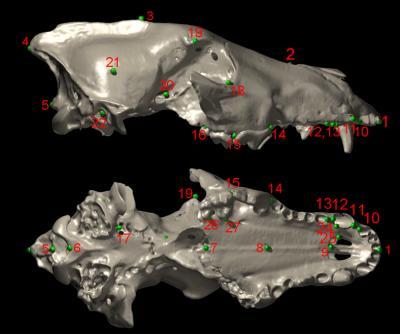LOS ANGELES — Concerns about climate change and its impact on the world around us are growing daily. New scientific studies at the La Brea Tar Pits are probing the link between climate warming and the evolution of Ice Age predators, attempting to predict how animals will respond to climate change today.
The La Brea Tar Pits are famous for the amazing array of Ice Age fossils found there, such as ground sloths, mammoths, and predators like saber-toothed cats and powerful dire wolves. But the climate during the end of the Ice Age (50,000-11,000 years ago) was unstable, with rapid warming and cooling. New research reported here has documented the impact of this climate change on La Brea predators for the first time.
Two new studies published by research associates at of the Page Museum document significant change over time in the skulls of both dire wolves and saber-toothed cats. "Different tar pits at La Brea accumulated at different times," said F. Robin O'Keefe of Marshall University, lead author on the dire wolf study (Palaeontologia Electronica, April 9, 2014). "When we compare fossils deposited at different times, we see big changes. We can actually watch evolution happening."
After the end of the last Ice Age, La Brea dire wolves became smaller and more graceful, adapting to take smaller prey as glaciers receded and climate warmed. This rapidly changing climate drove change in saber-toothed cats as well. "Saber-toothed cats show a clear correlation between climate and shape. Cats living after the end of the Ice Age are larger, and adapted to taking larger prey," said Julie Meachen of Des Moines University, lead author on the sabertooth study (Journal of Evolutionary Biology, 2014).
The two scientists discuss their work in a video here: http://www.youtube.com/watch?v=jK_DKSNbgR4&feature=youtu.be
"We can see animals adapting to a warming climate at La Brea," said O'Keefe. "Then humans show up and all the big ones disappear. We haven't been able to establish causality there yet. But we are working on it."

Dr. O'Keefe and Dr. Meachen used over 200 La Brea fossils in their research.
(Photo Credit: Page Museum at the La Brea Tar Pits)
The emerging links between climate change and evolution needs further study. There are many unanswered questions; such as why predators change in the ways that they do, the importance of factors other than climate, and whether the arrival of humans played a role in the mass extinction at the end of the Ice Age. "There is much work to be done on the specimens from the tar pits. We are working actively to bring together the researchers and resources needed to expand on these discoveries," says John Harris, chief curator at the Page Museum. "Climate change is a pressing issue for all of us, and we must take advantage of what Rancho La Brea can teach us about how ecosystems react to it."

A new dire wolf study documents the impact of climate change on La Brea Tar Pits predators for the first time.
(Photo Credit: Dr. Frank O'Keefe, Marshall University)